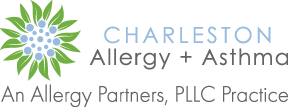In a seaside city with a rich culinary scene, you can be sure we see our fair share of food-related allergies! However, just because food allergies are common amongst our patients doesn’t mean there aren’t other issues we treat. In fact, food allergies only make up around 12% of allergies affecting children and adults combined. From seasonal symptoms to microscopic culprits, let’s explore some of the top non-food-related allergies and how we identify and treat them.
5 Common Non-Food-Related Allergies
According to the World Health Organization, the prevalence of general allergic diseases has been rising steadily in industrialized nations for more than 50 years. If tasty morsels are not to blame, you may be experiencing one of these common non-food-related allergies.
1. Allergic Rhinitis (Hay Fever)
Allergic rhinitis, often referred to as “hay fever” or “seasonal allergies,” affects more than 19 million adults and 5 million children nationwide. Symptoms are most commonly triggered by pollen, including stuffy or runny nose, sneezing, itchy or watery eyes and scratchy throat.
Avoidance is key in these cases, and tools like our online pollen count can help Lowcountry allergy sufferers plan their day around unnecessary pollen exposure. Over-the-counter medications like antihistamines and decongestants can also be effective in relieving symptoms. In some cases, immunotherapy can help reduce the severity and frequency of symptoms. Your board-certified allergist can help you devise a treatment plan specific to your needs.
2. Medications
These allergies can occur when the immune system overreacts to medication, causing symptoms ranging from mild skin rashes to life-threatening anaphylaxis. Common medications that can cause allergies include antibiotics, nonsteroidal anti-inflammatory drugs (NSAIDs) and topical medicines.
Managing drug allergies begins by paying close attention to your body. If you can identify when symptoms arise, narrowing down the cause becomes simpler. We recommend keeping a list of all medications you are allergic to and sharing this information with all healthcare providers. In some cases, skin or blood testing may be possible to determine which drugs are safe to use.
3. Insect Stings
Did you know that up to 40 million Americans are at risk of a severe insect allergy reaction? These allergies occur when the immune system overreacts to the venom of an insect sting, such as from a bee, wasp or fire ant. Symptoms can range from mild to severe, including swelling, difficulty breathing, abdominal pain, difficulty swallowing and anaphylaxis in severe cases.
To reduce your risk of a reaction, wear protective clothing outdoors (long sleeves, pants, etc.). Always remember to carry an epinephrine auto-injector if you have a known allergy and a history of severe reactions. If you are stung and experience severe symptoms, seek emergency medical attention immediately.
4. Pet-Related Allergies
Despite what breeders may have you believe, there is no such as a truly hypoallergenic pet. Pet-related allergies are caused by proteins found in the saliva, urine and dander of common household animals such as cats and dogs. Symptoms can range from mild to severe and include sneezing, runny nose, itchy and watery eyes, skin rashes and difficulty breathing.
While completely avoiding pet allergens can be difficult, creating “pet-free zones” in your home may help. Read our blog, “How to Help Your Child Overcome Their Pet Allergies,” to find valuable tips for all ages on living comfortably with your furry friends.
5. Dust Mites
Dust mites are tiny, nearly invisible creatures that live in dust and fabric fibers in our homes. They are a common allergy culprit and can cause sneezing, runny nose, itchy eyes, and in some cases, asthma symptoms.
Regular deep cleaning sessions of your home are critical for reducing symptoms and exposure to dust mites. Adding dust mite-proof bedding covers and removing carpets are more intensive measures that can help you effectively minimize dust mite counts.
Diagnosis of Non-Food-Related Allergies
If you are experiencing allergies, our local board-certified allergist can assist in diagnosing symptoms. Allergy diagnosis can be conducted via several methods, including:
Skin Prick Test
This relatively painless test involves exposure to small amounts of possible allergens via tiny needles that prick the skin. Once applied, the allergist will monitor the skin for signs of an allergic reaction. If the skin becomes red or has raised, itchy bumps at the test site, it may indicate an allergic reaction to a specific allergen.
Blood Test
Allergy blood tests can identify the specific IgE antibodies produced by the immune system in response to an allergen. Your allergist can determine if a blood test is needed to test for allergies.
Patch Test
This test is used for identifying delayed allergic reactions. Patch tests involve the application of a potential allergen via a patch left on the skin for several days. If you experience a reaction, you are likely allergic to that substance.
Our Allergists Are Here For You
At Charleston Allergy and Asthma, our award-winning board-certified allergy specialists are trained and equipped to guide you toward allergy relief. We provide Lowcountry patients with a full range of allergy treatments, including allergy diagnosis, immunotherapy treatment, food oral immunotherapy and more. Contact our team to schedule your next allergy appointment.




